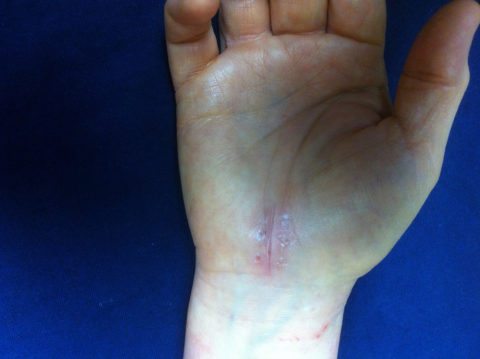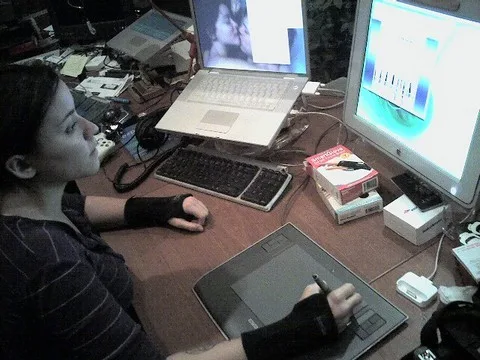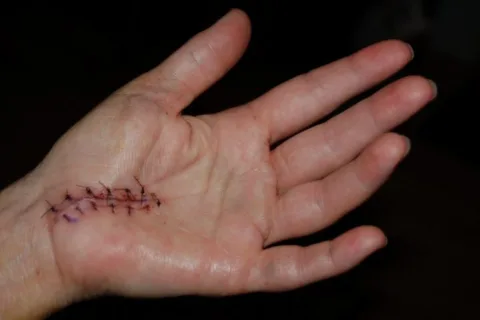As a writer and a former waitress, I’ve had to deal with symptoms related to carpal tunnel syndrome for years.

Though I’ve never officially been diagnosed with carpal tunnel, my mother has. In fact, she has had surgery for carpal tunnel. So I am very familiar with this condition.
Do you think you’ve got carpal tunnel syndrome? Here’s how to tell for sure…
Carpal Tunnel Symptoms
The most common symptoms of carpal tunnel syndrome include numbness and burning in the palm and fingers of your hand. The thumb, index and middle fingers are usually the most affected.

Severe cases of carpal tunnel make it difficult to grip objects, and some people lose the ability to tell the difference between hot and cold. Also, if left untreated, the muscles at the base of the thumb can waste away. But this is only in extreme cases that go untreated.
Carpal tunnel syndrome is caused when the tendons in the wrist swell and put pressure on the median nerve — a nerve which runs from the forearm to the hand. This nerve controls your sensations in the thumb, fingers and palm of that hand.
Now, let’s talk about some of the treatments including surgery for carpal tunnel, as well as some of the preventive measures you can take to avoid getting carpal tunnel syndrome in the first place…
Carpal Tunnel Treatments
Here are 7 non-surgical treatments for carpal tunnel:
#1 – Wear A Wrist Brace Or Splint
A carpal tunnel wrist brace or splint can be worn at night and during any activities during the day that may aggravate the symptoms of carpal tunnel syndrome.
#2 – Use Anti-Inflammatory Drugs
Your doctor may subscribe anti-inflammatory drugs (NSAIDS, such as Ibuprofen) to help with the pain.
#3 – Change Your Routine
Changing the activities that you do with your hand can help, as well. Although, if your job is typing or some other activity where you are using your wrists and hands a lot, this may not be an option. Generally speaking, you want to avoid holding your wrists in a downward bent position for long periods of time.
#4 – Try Pain Relieving Injections
Some doctors advocate giving carpal tunnel syndrome sufferers corticosteroid shots to help relieve the pain. However, they are only temporary and the pain and other symptoms can return.
#5 – Add B6, Riboflavin, And Biotin To Your Diet
Taking a supplement is the best way to do this. Just don’t take more than 100 milligrams of B6 without consulting your doctor. Too much B6 can make you sick — causing sensitivity to sunlight, a rash, and other nasty symptoms. Doctors aren’t quite sure what B6 does that helps carpal tunnel syndrome, but it is speculated that B6 acts as a diuretic causing the body to eliminate excess fluid. Whatever the reason, studies with animals have shown that B6 reduces pain, and patients who take it claim it works. Biotin and Riboflavin are also B vitamins and work synergistically with B6, so some doctors say you should take a supplement with all 3 in it.
#6 – Try Acupuncture
Acupuncture is another natural treatment for carpal tunnel syndrome. Again, researchers aren’t exactly sure why it works, but some believe that acupuncture releases natural pain-killing endorphins that help to relieve (and in some cases cure) carpal tunnel syndrome. In one study all of the people whose surgeries had failed to cure their carpal tunnel syndrome noticed marked improvements in their symptoms and pain.
#7 – Practice Yoga
There are a number of different yoga stretches that can help alleviate the symptoms associated with carpal tunnel syndrome. A number of these stretches include hand poses, but there are also some poses that stretch your back, spine, and shoulders which help as well. Here are some simple finger stretches you can try. Or, you could ask a partner to massage your hands for you.
Surgery To Treat Carpal Tunnel Syndrome
If the non-surgical treatments listed above don’t give you enough relief, and if your symptoms increase or become severe, you may want to explore carpal tunnel surgery.
Keep in mind, the surgery may come with its own set of problems:
- For one, it can cause nerve damage in your hand and wrist.
- Also, if the carpal tunnel syndrome has gone on a long time untreated, then there is the possibility that surgery may not provide as much relief and the recovery time could stretch out longer than a year.
What I’ve Learned About Surgery For Carpal Tunnel
On a personal note, my mother had carpal tunnel surgery back in the early 90s and she has lost almost all feeling in her fingers and hands due to what we believe is further nerve damage caused by the surgery.
Because of this, I would think long and hard before having surgery for carpal tunnel yourself. I would recommend trying all other methods before treating carpal tunnel syndrome with surgery.
While I’m sure that surgical techniques have improved since my mom had her surgery, I’m leery of trusting it since further damage to the median nerve is a clear possibility.
6 Ways To Avoid Getting Carpal Tunnel Syndrome
#1 – Take Frequent Breaks
When you’re typing or if you do another job that requires a lot of use of your hands, wrists, and arms take frequent breaks. This can go a long way towards protecting the median nerve from getting compressed which causes you to develop carpal tunnel syndrome.
#2 – Make Sure Your Knives Are Sharp
So you don’t have to apply as much pressure to the handle of the knife when you’re cutting something, make sure your knives are sharp. I have a tendency to let my kitchen knives get dull and before I know it, I’m having to press on both the handle and the knife to cut something. This is not a good thing if you’re trying to avoid getting carpal tunnel syndrome.
#3 – Perform Stretching Exercises
While on the computer or if you’re seated at work for long hours at a time try some stretching exercises. As a full-time writer I have to remind myself of this one often, and I frequently get up and stretch, walk around, shake my hands, and wiggle my fingers.
#4 – Wear Splints While Working
If you have to sit at a desk typing all day, consider wearing carpal tunnel splints to keep your wrists straightened out. I know a lot of writers who don’t type unless they have their splints on.
#5 – Wear Fingerless Gloves
Keep your hands warm and flexible by wearing fingerless gloves. I’ve seen more than one typist use these. According to many of my writer friends, they work very well — especially if you have wrist rests too!
#6 – Use Wrist Rests For Your Keyboard And Mouse

If your job requires you to spend a lot of time at the computer, try wrist rests. These are really helpful because your wrist rests comfortably on them, so there’s a lot less chance of straining your wrists or compressing your median nerve. Here are some other ways to make your computer space ergonomic in order to prevent carpal tunnel syndrome.
As you can see, curing carpal tunnel syndrome isn’t easy. And surgery isn’t always the best option either. So the best course of action is to try to do everything in your power to prevent getting carpal tunnel syndrome in the first place.
If you begin noticing carpal tunnel symptoms, try some of the non-surgical and natural treatments mentioned above first. If they don’t help, then it’s time to schedule a visit to the doctor to get a proper diagnosis. There are other ailments with symptoms that closely mimic carpal tunnel syndrome, so you need to rule out those other possibilities sooner rather than later.
My favorite things to write about are topics that have to do with weather, pregnancy, weddings, saving money, living green, and my life with dogs. When I’m not writing, I love to spend time with my husband, read, create 3D artwork and Native American beadwork.




